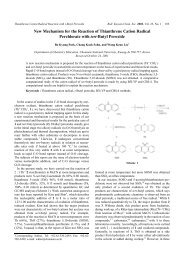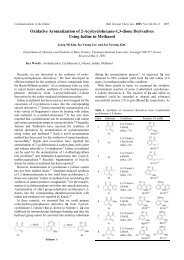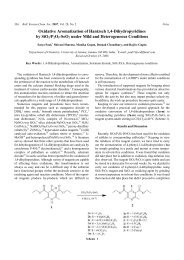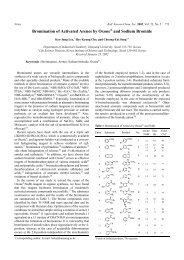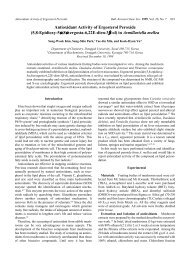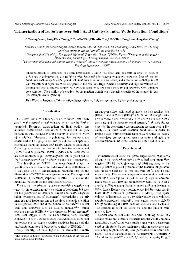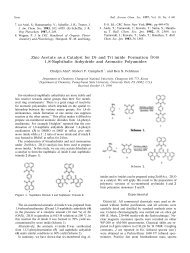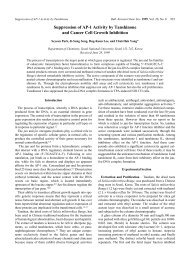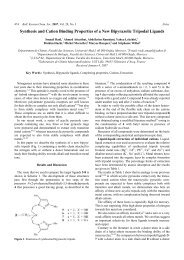Oxidative nucleophilic substitution of hydrogen in ... - EaseChem.com
Oxidative nucleophilic substitution of hydrogen in ... - EaseChem.com
Oxidative nucleophilic substitution of hydrogen in ... - EaseChem.com
You also want an ePaper? Increase the reach of your titles
YUMPU automatically turns print PDFs into web optimized ePapers that Google loves.
Issue <strong>in</strong> Honor <strong>of</strong> Pr<strong>of</strong>. Giuseppe Bartoli ARKIVOC 2006 (vi) 59-66<br />
<strong>Oxidative</strong> <strong>nucleophilic</strong> <strong>substitution</strong> <strong>of</strong> <strong>hydrogen</strong> <strong>in</strong> nitroarenes with<br />
an oxazol<strong>in</strong>e-stabilized carbanion<br />
Saverio Florio,* a Mieczyslaw Makosza,* b Patrizia Lorusso, c and Luig<strong>in</strong>o Troisi c<br />
a Dipartimento Farmaco-Chimico, University <strong>of</strong> Bari, Via E. Orabona 4, 70126 Bari, Istituto di<br />
Chimica dei Composti Organometallici “ICCOM”, Sezione di Bari, Italy; b Institute <strong>of</strong> Organic<br />
Chemistry, Polish Academy <strong>of</strong> Sciences ul. Kasprzaka 44, 01-224 Warszawa 42, POB 58,<br />
Poland; c Dipartimento di Scienze e Tecnologie Biologiche ed Ambientali, University <strong>of</strong><br />
Lecce,Via Prov. le Lecce-Monteroni, 73100 Lecce, Italy<br />
E-mail: florio@farmchim.uniba.it; icho-s@icho.edu.pl<br />
Dedicated to Pr<strong>of</strong>essor Giuseppe Bartoli on the occasion <strong>of</strong> his 65th Anniversary<br />
Abstract<br />
The carbanion <strong>of</strong> 4,4-dimethyl-2-(1-phenylethyl)-4,5-dihydro-1,3-oxazole adds 1 to nitroarenes<br />
<strong>in</strong> the position para to the nitro group: oxidation <strong>of</strong> the produced σ H adducts with<br />
dichlorodicyanobenzoqu<strong>in</strong>one (DDQ) gives para-substituted nitroarenes whereas oxidation with<br />
dimethyldioxirane (DMD) leads to para- substituted phenols.<br />
Keywords: Carbanions, nitroarenes, VNS reaction, ONSH reaction, oxazol<strong>in</strong>es, phenols<br />
Introduction<br />
Nucleophilic <strong>substitution</strong> <strong>of</strong> <strong>hydrogen</strong> <strong>in</strong> nitroarenes and other electron-deficient arenes is a well<br />
recognized process <strong>of</strong> substantial value <strong>in</strong> organic synthesis. 1,2 There are two ma<strong>in</strong> variants <strong>of</strong><br />
this process: vicarious and oxidative <strong>nucleophilic</strong> <strong>substitution</strong>. The key step <strong>of</strong> both <strong>of</strong> these<br />
reactions is the formation <strong>of</strong> σ H adducts via addition <strong>of</strong> nucleophiles to the electron-deficient<br />
aromatic r<strong>in</strong>gs <strong>in</strong> positions occupied with <strong>hydrogen</strong>. When the nucleophiles conta<strong>in</strong> leav<strong>in</strong>g<br />
groups L at the <strong>nucleophilic</strong> center, e.g., α-halocarbanions or alkyl hydroperoxide anions further<br />
transformation <strong>of</strong> the σ H adducts proceeds with base-<strong>in</strong>duced β-elim<strong>in</strong>ation <strong>of</strong> HL giv<strong>in</strong>g<br />
products <strong>of</strong> vicarious <strong>nucleophilic</strong> <strong>substitution</strong> (VNS). 3,4 On the other hand, oxidation <strong>of</strong> the σ H<br />
adducts with external oxidants results <strong>in</strong> oxidative <strong>nucleophilic</strong> <strong>substitution</strong> <strong>of</strong> <strong>hydrogen</strong><br />
(ONSH). 5 Of particular value <strong>in</strong> organic synthesis is the <strong>nucleophilic</strong> oxidative alkylation <strong>of</strong><br />
nitroarenes with Grignard reagents, pioneered by Bartoli. 6,7 He has shown that alkyl Grignard<br />
reagents add to the electron-deficient r<strong>in</strong>gs <strong>of</strong> nitroarenes, while subsequent oxidation <strong>of</strong> the<br />
ISSN 1424-6376 Page 59<br />
© ARKAT
Issue <strong>in</strong> Honor <strong>of</strong> Pr<strong>of</strong>. Giuseppe Bartoli ARKIVOC 2006 (vi) 59-66<br />
produced σ H adducts with a variety <strong>of</strong> oxidants gives the alkylation products. Recently, it has<br />
been found that the most efficient reagent for oxidation <strong>of</strong> these σ H adducts is KMnO4 <strong>in</strong> liquid<br />
ammonia. 8 However, the ONSH reaction <strong>in</strong> nitroarenes with stabilized carbanions is somewhat<br />
limited ow<strong>in</strong>g to the reversibility <strong>of</strong> the σ H adducts formation. Nevertheless, it serves as a<br />
valuable tool for the <strong>in</strong>troduction <strong>of</strong> functionalized alkyl substituents <strong>in</strong>to aromatic r<strong>in</strong>gs. 5,9<br />
Oxazol<strong>in</strong>es have be<strong>com</strong>e well established as highly versatile <strong>com</strong>pounds <strong>in</strong> organic synthesis.<br />
The heterocyclic system serves as a latent function that can be transformed <strong>in</strong>to a variety <strong>of</strong> other<br />
functional groups, while most <strong>of</strong> the chemical manipulations <strong>in</strong>volve the development <strong>of</strong><br />
substituents borne at the 2-position. One <strong>of</strong> the key features <strong>of</strong> the oxazol<strong>in</strong>e system is the<br />
stabilization <strong>of</strong> carbanions generated at the α-center <strong>of</strong> a 2-alkyl derivative and subsequent<br />
reactions <strong>of</strong> such carbanions with a variety <strong>of</strong> electrophilic reagents. 10a Follow<strong>in</strong>g the pioneer<strong>in</strong>g<br />
work <strong>of</strong> Meyers, 1a this reactivity has been exploited extensively <strong>in</strong> asymmetric synthesis. 10b,c<br />
Metallated α-hetero-substituted 2-alkyloxazol<strong>in</strong>es have been <strong>in</strong>vestigated extensively <strong>in</strong> the<br />
laboratory <strong>of</strong> one <strong>of</strong> the authors, as well as the synthetic applications. 11<br />
Recently, we have reported that carbanions <strong>of</strong> α-chloroalkyl- and dichloromethyl- oxazol<strong>in</strong>es<br />
undergo the VNS reaction with a variety <strong>of</strong> nitroarenes, produc<strong>in</strong>g nitrobenzyloxazol<strong>in</strong>es 12 and<br />
α-chloronitrobenzyl oxazol<strong>in</strong>es. 13 The latter <strong>com</strong>pounds can enter <strong>in</strong> situ the Darzens reaction<br />
with aldehydes giv<strong>in</strong>g nitroaryl oxazol<strong>in</strong>yl oxiranes. 13<br />
In order to extend the scope <strong>of</strong> the methods for <strong>in</strong>troduction <strong>of</strong> alkyloxazol<strong>in</strong>yl substituents<br />
<strong>in</strong>to nitro-aromatic r<strong>in</strong>gs we have studied ONSH <strong>in</strong> nitroarenes with a carbanion stabilized by the<br />
oxazol<strong>in</strong>yl group. The nature <strong>of</strong> the carbanion-stabiliz<strong>in</strong>g group that decides the <strong>nucleophilic</strong>ity<br />
<strong>of</strong> the carbanion, and hence the addition equilibrium and orientation <strong>of</strong> the addition due to steric<br />
effect, is <strong>of</strong> crucial importance <strong>in</strong> the reactions <strong>of</strong> the carbanion with nitroarenes.<br />
Results and Discussion<br />
As a model carbanion precursor for the ONSH reaction we have chosen 4,4-dimethyl-2-(1phenylethyl)-4,5-dihydro-1,3-oxazol<strong>in</strong>e<br />
1, readily prepared from 2-phenylpropionic acid and 2am<strong>in</strong>o-2-methyl<br />
propanol. 14 The phenyl group <strong>in</strong> 1 provides additional stabilization to the<br />
carbanion, assur<strong>in</strong>g facile deprotonation <strong>of</strong> 1 and proper <strong>nucleophilic</strong>ity <strong>of</strong> the carbanion. Due to<br />
steric effects <strong>of</strong> the large oxazol<strong>in</strong>yl moiety and the methyl and phenyl groups, addition <strong>of</strong> the<br />
tertiary carbanion <strong>of</strong> 1 to nitroarenes should proceed exclusively <strong>in</strong> the para position, whereas<br />
products <strong>of</strong> the ONSH reaction are not CH acids so they should be stable <strong>in</strong> the reaction medium<br />
<strong>in</strong> the presence <strong>of</strong> bases and oxidants. In some prelim<strong>in</strong>ary experimentation we found that the<br />
ONSH reaction <strong>of</strong> 1 proceeds efficiently when the carbanion is generated upon treatment <strong>of</strong> 1<br />
with t-BuOK <strong>in</strong> THF at low temperature <strong>in</strong> the presence <strong>of</strong> the nitroarene, and the produced σ H<br />
adducts are subsequently oxidized by dichlorodicyanobenzoqu<strong>in</strong>one (DDQ) to give the<br />
nitroarene conta<strong>in</strong><strong>in</strong>g an alkyloxazol<strong>in</strong>e substituent para to the nitro group (Scheme 1a).<br />
ISSN 1424-6376 Page 60<br />
© ARKAT
Issue <strong>in</strong> Honor <strong>of</strong> Pr<strong>of</strong>. Giuseppe Bartoli ARKIVOC 2006 (vi) 59-66<br />
Ph<br />
Me<br />
CH<br />
O N<br />
1<br />
+<br />
NO 2<br />
2 − 9<br />
X = Oxazol<strong>in</strong>e<br />
Z = H, Cl, Br, MeO, CN, EtO, NO 2<br />
Scheme 1<br />
Z<br />
t-BuOK<br />
THF<br />
H<br />
NO 2<br />
X Ph NO2<br />
−<br />
Me<br />
Z<br />
DDQ<br />
DMF<br />
DMD<br />
acetone<br />
Ph<br />
Ph<br />
Me<br />
Me<br />
OH<br />
X<br />
X<br />
2b − 8b<br />
Z<br />
2a − 9a<br />
The results presented <strong>in</strong> Table 1 show that the ONSH reaction proceeds satisfactorily under<br />
these conditions, giv<strong>in</strong>g the expected products <strong>of</strong> para <strong>substitution</strong> <strong>in</strong> moderate to excellent<br />
yields. Another efficient base solvent system for the ONSH reaction with carbanions is NaNH2<br />
<strong>in</strong> liquid ammonia with KMnO4 as the oxidant. 15 We have found that this system can also be<br />
applied for the reaction <strong>of</strong> 1. Treatment <strong>of</strong> 1 with NaNH2 <strong>in</strong> liquid ammonia and subsequently<br />
with nitrobenzene and KMnO4 gave 2a <strong>in</strong> an excellent yield (90%).<br />
Anionic σ H adducts <strong>of</strong> the addition <strong>of</strong> carbanions to nitroarenes can be oxidized also by<br />
dimethyldioxirane (DMD): however, this oxidizes the negatively charged nitro groups, so that<br />
the f<strong>in</strong>al products are substituted phenols. 16 This oxidant can also be applied to the oxidation <strong>of</strong><br />
the σ H adducts derived from the oxazol<strong>in</strong>e-stabilized carbanion <strong>of</strong> 1 and nitroarenes. A series <strong>of</strong><br />
phenols conta<strong>in</strong><strong>in</strong>g alkyl oxazol<strong>in</strong>yl substituents <strong>in</strong> the para position was obta<strong>in</strong>ed by this way<br />
(Scheme 1b).<br />
Conclusions<br />
We have shown that the oxidative <strong>nucleophilic</strong> <strong>substitution</strong> <strong>of</strong> <strong>hydrogen</strong> <strong>in</strong> nitroarenes with the<br />
stabilized carbanion derived from 4,4-dimethyl-2-(1-phenylethyl)-4,5-dihydro-1,3-oxazole 1<br />
proceeds efficiently. Oxidation <strong>of</strong> the <strong>in</strong>termediate σ H adducts derived from this carbanion and<br />
nitroarenes with DDQ and DMD permits the preparation <strong>of</strong> para-nitrobenzyl- and parahydroxybenzyl-<br />
oxazol<strong>in</strong>es respectively, which are valuable <strong>in</strong>termediates <strong>in</strong> organic synthesis.<br />
ISSN 1424-6376 Page 61<br />
Z<br />
a<br />
b<br />
© ARKAT
Issue <strong>in</strong> Honor <strong>of</strong> Pr<strong>of</strong>. Giuseppe Bartoli ARKIVOC 2006 (vi) 59-66<br />
Table 1. Oxidation <strong>of</strong> σ H adducts <strong>of</strong> 1 − to nitroarenes by DDQ and DMD accord<strong>in</strong>g to Scheme 1<br />
Oxidant<br />
Entry Z No. DDQ DMD<br />
product Yield % Product Yield %<br />
1 H 2 2a 95 2b 53<br />
2 3-Cl 3 3a 90 3b 74<br />
3 2-Cl 4 4a 78<br />
4 3-Br 5 5a 74 5b 68<br />
5 2-Br 6 6a 74<br />
6 2-OMe 7 7a 92<br />
7 3-CN 8 8a 58 8b 35<br />
8<br />
4-EtO-3-<br />
NO2<br />
9 9a 63<br />
Experimental Section<br />
General Procedures. Melt<strong>in</strong>g po<strong>in</strong>ts were uncorrected. 1 H NMR spectra were recorded <strong>in</strong><br />
CDCl3 on 200 MHz or 400 MHz <strong>in</strong>struments. Mass spectra were measured on an AMD 604<br />
Inectra GmbH spectrometer us<strong>in</strong>g EI. For column chromatography, silica gel (230-400 mesh),<br />
Merck, was used. DMF was distilled over calcium hydride and stored over molecular sieves;<br />
tetrahydr<strong>of</strong>uran was distilled over potassium benzophenone ketyl. Potassium tert-butoxide was<br />
reagent grade purchased from Fluka. An acetone solution <strong>of</strong> DMD was prepared accord<strong>in</strong>g to the<br />
procedure described by Adam et al. 17 All reactions were performed under an argon atmosphere.<br />
The start<strong>in</strong>g nitroarenes were <strong>com</strong>mercial products. 4,4-dimethyl-2-(1-phenylethyl)-4,5dihydro-1,3-oxazole<br />
1 was prepared start<strong>in</strong>g from 2-phenylpropionic acid follow<strong>in</strong>g a procedure<br />
reported <strong>in</strong> ref. 14.<br />
In a 100-ml round bottom flask, 2-phenylpropionic acid (100 mmol) and 2-am<strong>in</strong>o-2-methylpropanol<br />
(100 mmol) were added <strong>in</strong> 50 ml <strong>of</strong> xylene. The flask was connected with a Dean-Stark<br />
apparatus, warmed up to 150°C, and heated under reflux for about 15 h, until no more water was<br />
collected. A solution <strong>of</strong> sodium bicarbonate (40ml, NaHCO3 10%) was added, and the mixture<br />
extracted with methylene chloride (3 x 20 ml). The solvent was evaporated and the product,<br />
identified as 2-(1-Phenylethyl)-4,4-dimethyl-2-oxazol<strong>in</strong>e (1), was purified by distillation (127°C<br />
at 0.1 mbar). Colorless oil, yield 70%. 1 H NMR (200 MHz) δ 7.28-7.38 (m, 5 H), 3.92-3.85 (m,<br />
2 H), 3.71 (q, J = 7.1 Hz, 1 H), 1.54 (d, J = 7.1 Hz, 3 H), 1.30 (m, 6 H); 13 C NMR (50 MHz,<br />
CDCl3) δ 167.5, 141.6, 128.5, 127.1, 126.2, 79.0, 66.7, 39.4, 28.3, 28.1; GC-MS (70 eV) m/z<br />
(%): 203 (M + , 100), 188 (98), 126 (60), 105 (97), 91 (57), 77 (73); FT-IR (film, cm -1 ): 2950,<br />
1662 (s, C=N), 1430, 1250, 1145.<br />
ISSN 1424-6376 Page 62<br />
© ARKAT
Issue <strong>in</strong> Honor <strong>of</strong> Pr<strong>of</strong>. Giuseppe Bartoli ARKIVOC 2006 (vi) 59-66<br />
Procedure for the oxidative <strong>substitution</strong> <strong>of</strong> <strong>hydrogen</strong> with 4,4-dimethyl-2-(1-phenylethyl)-<br />
4,5-dihydro-1,3-oxazole (1) with t-BuOK <strong>in</strong> nitroarenes and DDQ. To a stirred solution <strong>of</strong> t-<br />
BuOK (2.5 mmol) <strong>in</strong> a mixture <strong>of</strong> THF and DMF (50:50) at -70°C, a solution <strong>of</strong> nitroarene (1.05<br />
mmol) and oxazol<strong>in</strong>e 1 (1 mmol) <strong>in</strong> THF (1 ml) was added. After 15 m<strong>in</strong>utes a solution <strong>of</strong> DDQ<br />
(1.2 mmol) <strong>in</strong> DMF (1 ml) was added at -70°C. The reaction mixture was stirred at this<br />
temperature for 10 m<strong>in</strong>utes, treated with an aqueous solution <strong>of</strong> ammonium chloride and the<br />
cool<strong>in</strong>g bath was removed. The crude material was extracted with methylene chloride (3x20 ml).<br />
The solvent was evaporated and the products purified by column chromatography us<strong>in</strong>g hexaneethyl<br />
acetate 5:1 as eluent, or recrystallized from n-heptane.<br />
<strong>Oxidative</strong> <strong>substitution</strong> <strong>of</strong> <strong>hydrogen</strong> with 4,4-dimethyl-2-(1-phenylethyl)-4,5-dihydro-1,3oxazole<br />
(1) and t-BuOK <strong>in</strong> nitroarenes and DMD. To a stirred solution <strong>of</strong> t-BuOK (2.5 mmol)<br />
<strong>in</strong> THF at -70°C a solution <strong>of</strong> oxazol<strong>in</strong>e 1 (1 mmol) <strong>in</strong> 0.5 ml <strong>of</strong> DMF was added. After 3 m<strong>in</strong> a<br />
solution <strong>of</strong> the nitroarene (1.2 mmol) <strong>in</strong> THF was added, and the mixture stirred at this<br />
temperature for 15 m<strong>in</strong>; water (18 µl, 1.2 mmol) and then an acetone solution <strong>of</strong> DMD (ca. 1.2<br />
mmol, 20ml <strong>of</strong> ca. 0.06 M) was added to the mixture. After 10 m<strong>in</strong>utes, aqueous ammonium<br />
chloride was added and the cool<strong>in</strong>g bath was removed. The crude product was extracted with<br />
methylene chloride (3 x 20 ml), the solvent evaporated, and the phenols purified from traces <strong>of</strong><br />
the correspond<strong>in</strong>g nitro- derivatives by column chromatography us<strong>in</strong>g hexane-ethyl acetate, 7:3,<br />
as eluent.<br />
4,4-Dimethyl-2-[1-(4-nitrophenyl)-1-phenylethyl]-4,5-dihydro-oxazole (2a). Yellow crystals,<br />
m. p. 79-80°C (n-heptane), yield 95%. 1 H NMR (400 MHz) δ 8.18-8.10 (m, 2 H), 7.47-7.39 (m,<br />
2 H), 7.38-7.27 (m, 3 H), 7.27-7.20 (m, 2 H), 4.02-3.90 (m, 2 H), 2.02 (s, 3 H), 1.36 (s, 3H), 1.29<br />
(s, 3 H). 13 C NMR (100 MHz) δ 167.8, 152.6, 146.6, 143.4, 129.1, 128.4, 127.6, 127.3, 123.1,<br />
79.4, 67.3, 50.4, 28.1, 27.9, 24.0. EI MS m/z (%): 324 (70), 323 (100), 294 (3), 226 (14), 178<br />
(11). Anal. Calcd for C19H20N2O3 (M = 324.38): C, 70.35; H, 6.38, N 8.64; Found: C 70.45; H,<br />
6.38; N, 8.49%. HR MS (EI): Calc. for C19H20N2O3 M = 324.1474; Found M = 324.1468.<br />
2-[1-(2-Chloro-4-nitrophenyl)-1-phenylethyl]-4,4-dimethyl-4,5-dihydro-1,3-oxazole (3a).<br />
Yellow crystals, m. p. 103-104°C (n-heptane), yield 90%. 1 H NMR (400 MHz) δ 8.23 (d, 1 H, J<br />
= 2.3 Hz), 7.90 (dd, 1 H, J = 8.8, 2.3 Hz), 7.54-7.47 (m, 2 H), 7.44-7.34 (m, 3 H), 6.95 (d, 1 H, J<br />
= 8.8 Hz), 4.02-3.95 (m, 2 H), 2.12 (s, 3 H), 1.34 (s, 3 H), 1.20 (s, 3 H). 13 C NMR (100 MHz) δ<br />
166.9, 150.5, 146.8, 141.5, 135.1, 130.7, 128.6, 127.7, 127.2, 126.2, 121.3, 70.5, 67.4, 50.3, 27.9,<br />
27.8, 23.8. Anal. Calcd. for C19H19ClN2O3 (358.82): C, 63.60; H, 5.34; Cl, 9.88; N, 7.81. Found:<br />
C, 63.71; H, 5.21; Cl, 9.62; N, 7.80.<br />
2-[1-(3-Chloro-4-nitrophenyl)-1-phenylethyl]-4,4-dimethyl-4,5-dihydro-1,3-oxazole (4a).<br />
Yellow oil, yield 78%. 1 H NMR (400 MHz) δ 7.81 (d, 1 H, J = 8.6 Hz), 7.43 (d, 1 H, J = 2.0 Hz),<br />
7.39-7.20 (m, 6 H), 4.16-4.07 (m, 2 H), 1.96 (s, 3 H), 1.33 (s, 3 H), 1.31 (s, 3 H). 13 C NMR (100<br />
MHz, CDCl3) δ 167.3, 151.6, 146.1, 142.9, 131.6, 128.5, 127.6, 127.5, 127.4, 127.2, 125.2, 79.5,<br />
67.4, 50.1, 28.2, 28.1, 27.9. HR MS (EI): HRMS (EI): Calcd. for C19H19 35 ClN2O3: 358.1084.<br />
Found: 358.1091.<br />
ISSN 1424-6376 Page 63<br />
© ARKAT
Issue <strong>in</strong> Honor <strong>of</strong> Pr<strong>of</strong>. Giuseppe Bartoli ARKIVOC 2006 (vi) 59-66<br />
2-[1-(2-Bromo-4-nitrophenyl)-1-phenylethyl]-4,4-dimethyl-4,5-dihydro-1,3-oxazole (5a).<br />
Yellow crystals, m. p. 114-115°C (n-heptane), yield 74%. 1 H NMR (400 MHz) δ 8.44 (d, 1 H, J<br />
= 2.4 Hz), 7.96 (dd, 1 H, J = 8.8 and 2.4 Hz), 7.55-7.50 (m, 2 H), 7.40-7.30 (m, 3 H), 6.99 (d, 1<br />
H, J = 8.8 Hz), 4.03-3.97 (m, 2 H), 2.15 (s, 3 H), 1.35 (s, 3 H), 1.20 (s, 3 H). 13 C NMR (100<br />
MHz) δ 166.7, 151.8, 146.5, 141.6, 130.8, 129.7, 128.5, 128.2, 127.7, 124.1, 121.7, 79.4, 67.4,<br />
51.4, 27.8, 27.7, 24.1. Anal. Calcd. for C19H19BrN2O3 (403.27): C, 56.59; H, 4.75; Br, 19.81; N,<br />
6.95. Found: C, 56.46; H, 4.70; Br, 19.86; N, 7.26. HRMS (EI): Calcd. for C19H19 79 BrN2O3:<br />
402.0579. Found: 402.0571. MS EI m/z (%): 403 (64), 402 (50), 323 (100), 304 (16), 203 (20),<br />
178 (19), 105 (100).<br />
2-[1-(3-Bromo-4-nitrophenyl)-1-phenylethyl]-4,4-dimethyl-4,5-dihydro-1,3-oxazole (6a).<br />
Yellow oil, yield 74%. 1 H NMR (400 MHz) δ 7.78 (d, 1H, J = 8.5 Hz), 7.62 (d, 1H, J = 2.1 Hz),<br />
7.38-7.20 (m, 6H), 4.00-3.90 (m, 2H), 1.96 (s, 3H), 1.33 (s, 3H), 1.31 (s, 3H). 13 C NMR (100<br />
MHz) δ 167.3, 151.5, 148.0, 142.9, 134.7, 128.5, 128.3, 127.5, 127.4, 125.2, 114.2, 79.5, 67.4,<br />
50.0, 28.3, 28.1. HR MS (EI): Calc. for C19H20N2O3 79 Br M +H + = 403.0652; Found M =<br />
403.0668. MS EI m/z (%): 403 (100), 402 (70), 323 (70), 304 (20), 178 (35).<br />
2-[1-(3-Methoxy-4-nitrophenyl)-1-phenylethyl]-4,4-dimethyl-4,5-dihydro-1,3-oxazole (7a).<br />
Yellow oil, yield 92%. 1 H NMR (400 MHz) δ 7.80 (d, 1 H, J = 8.6 Hz), 7.39-7.20 (m, 5 H), 7.01<br />
(d, 1 H, J = 1.9 Hz), 6.94 (dd, 1 H, J = 8.6 and 1.9 Hz), 4.00-3.91 (m, 2 H), 3.83 (s, 3 H), 1.97 (s,<br />
3 H), 1.33 (s, 3 H), 1.32 (s, 3 H). 13 C NMR (100 MHz) δ 167.9, 152.5, 152.3, 143.4, 137.9,<br />
128.3, 127.7, 127.3, 125.3, 120.0, 113.8, 79.4, 67.3, 56.3, 50.5, 28.1, 28.0, 23.0. HR MS (EI):<br />
Calc. for C20H22N2O4, M = 354.1579; Found M = 354.1567.<br />
2-[1-(4,4-Dimethyl-4,5-dihydro-1,3-oxazol-2-yl)-1-phenylethyl]-5-nitrobenzenecarbonitrile<br />
(8a). Yellow crystals, m. p. 155-157°C (n-heptane), yield 58%. 1 H NMR (400 MHz) δ 8.52 (d, 1<br />
H, J = 2.5 Hz), 8.17 (dd, 1 H, J = 8.8 and 2.5 Hz), 7.51-7.40 (m, 5 H), 7.00 (d, 1 H, J = 8.8 Hz),<br />
4.16-4.00 (m, 2 H), 2.17 (s, 3 H), 1.36 (s, 3H), 1.31 (s, 3 H). 13 C NMR (100 MHz) δ 172.1,<br />
156.1, 146.1, 140.3, 130.1, 129.5, 128.9, 128.3, 127.6, 126.7, 116.8, 114.5, 79.8, 67.9, 50.3, 27.9,<br />
27.5, 25.0. Anal. Calcd. for C20H19N3O3 (349.39): C, 68.75; H, 5.48; N, 12.03. Found: C, 68.53;<br />
H, 5.27; N, 11.78.<br />
2-[1-(4,4-Dimethyl-4,5-dihydro-1,3-oxazol-2-yl)-1-phenylethyl]-4-ethoxy-5-nitropyrid<strong>in</strong>e<br />
(9a). Colorless crystals, m. p. 92-93°C (n-heptane), yield 63%. 1 H NMR (400 MHz) δ 8.96 (s, 1<br />
H), 7.39-7.28 (m, 5 H), 6.91 (s, 1 H), 4.03 (dq, 2 H, J = 7.0 and 1.5 Hz), 4.00-3.91 (m, 2 H), 2.04<br />
(s, 3 H), 1.39 (t, 3 H, J = 7.0 Hz), 1.34 (s, 3 H), 1.32 (s, 3 H). 13 C NMR (100 MHz): δ 169.7,<br />
167.5, 158.0, 145.9, 143.1, 135.1, 128.4, 127.5, 127.3, 108.9, 79.4, 67.3, 65.3, 53.2, 28.1, 26.5,<br />
14.0. Anal. Calcd. for C20H23N3O4 (369.42): C, 65.03; H, 6.28; N, 11.37. Found: C, 65.12; H,<br />
6.40; N, 11.27. HRMS (EI): Calcd. for C20H23N3O4: 369.16899. Found: 369.1700.<br />
4-[1-(4,4-Dimethyl-4,5-dihydro-1,3-oxazol-2-yl)-1-phenylethyl]phenol (2b). Colorless<br />
crystals, m. p. 207-209°C (ethanol), yield 53%. 1 H NMR (200 MHz) δ 9.92 (s, 1 H, broad), 7.42-<br />
7.29 (m, 5 H), 7.11-7.01 (m, 2 H), 6.69-6.61 (m, 2 H), 4.09-4.00 (m, 2 H), 2.02 (s, 3 H), 1.43 (s,<br />
3 H), 1.41 (s, 3 H). 13 C NMR (50 MHz) δ 170.5, 155.0, 144.8, 135.9, 128.9, 128.1, 127.5, 126.7,<br />
ISSN 1424-6376 Page 64<br />
© ARKAT
Issue <strong>in</strong> Honor <strong>of</strong> Pr<strong>of</strong>. Giuseppe Bartoli ARKIVOC 2006 (vi) 59-66<br />
115.2, 79.4, 67.0, 49.5, 28.2, 28.1, 27.8. Anal. Calcd. for C19H21NO2 (295.38): C, 77.26; H, 7.17;<br />
N, 4.74. Found: C, 77.26; H, 7.32; N, 4.75.<br />
3-Chloro-4-[1-(4,4-dimethyl-4,5-dihydro-1,3-oxazol-2-yl)-1-phenylethyl]phenol (3b). Color-<br />
less crystals, m. p. 213-215 o C (ethanol), yield 74%. 1 H NMR (200 MHz) δ 10.26 (s, 1 H, broad),<br />
7.58-7.48 (m, 2 H), 7.46-7.30 (m, 3 H), 6.68 (d, 1 H, J = 2.5 Hz), 6.38 (d, 1 H, J = 8.8 Hz), 6.26<br />
(dd, 1 H, J = 8.8 and 2.5 Hz), 4.21-4.00 (m, 2 H), 2.09 (s, 3 H), 1.51 (s, 3 H), 1.37 (s, 3 H). 13 C<br />
NMR (50 MHz) δ 171.0, 156.7, 141.9, 133.0, 132.6, 129.9, 128.3, 128.0, 127.2, 119.1, 114.2,<br />
79.7, 67.1, 49.3, 31.8, 27.9, 27.8. Calc. for C19H20NO2Cl (M = 329.83): C, 69.19; H, 6.11; N<br />
4.25; Cl, 10.75. Found: C 69.33; H, 6.29; N, 4.43; Cl, 10.45.<br />
3-Bromo-4-[1-(4,4-dimethyl-4,5-dihydro-1,3-oxazol-2-yl)-1-phenylethyl]phenol (5b). Colorless<br />
crystals, m. p. 208-209 o C (ethanol), yield 68%. 1 H NMR (200 MHz) δ 10.10 (s, 1 H, broad),<br />
7.55-7.49 (m, 2 H), 7.41-7.30 (m, 3 H), 6.94 (d, 1 H, J = 2.5 Hz), 6.46 (d, 1 H, J = 8.8 Hz), 6.34<br />
(dd, 1 H, J = 8.8 and 2.5 Hz), 4.18-4.00 (m, 2 H), 2.11 (s, 3 H), 1.51 (s, 3 H), 1.38 (s, 3 H). 13 C<br />
NMR (50 MHz) δ 170.8, 156.8, 141.8, 133.6, 130.3, 128.4, 128.3, 127.4, 123.5, 122.4, 114.8,<br />
80.0, 66.8, 50.5, 27.7, 27.6. 25.3. Anal. Calcd. for C19H20BrNO2 (374.28): C, 60.97; H, 5.39; Br,<br />
21.35; N, 3.74. Found: C, 61.18; H, 5.20; Br, 21.24; N, 3.69.<br />
2-[1-(4,4-Dimethyl-4,5-dihydro-oxazol-2-yl)-1-phenylethyl]-5-hydroxy-benzonitrile (8b).<br />
Colorless crystals, m. p. 231-232 o C (ethanol), yield 35%. 1 H NMR (400 MHz) δ 10.23 (s, 1 H,<br />
broad), 7.52-7.35 (m, 5 H), 6.73 (d, 1 H, J = 2.7 Hz), 6.56 (dd, 1 H, J = 8.8 and 2.7 Hz), 6.35 (d,<br />
1 H, J = 8.8 Hz), 4.25 (d, 1 H, J = 8.25 Hz), 4.06 (d, 1 H, J = 8.25 Hz), 2.13 (s, 3 H), 1.59 (s, 3<br />
H), 1.36 (s, 3 H). 13 C NMR (100 MHz) δ 171.2, 155.8, 140.7, 139.0, 129.8, 128.8, 127.9, 127.6,<br />
122.1, 120.2, 119.2, 112.2, 79.9, 67.4, 49.4, 27.9, 27.5, 25.0. Anal. Calcd. for C20H20N2O2<br />
(320.39): C, 74.98; H, 6.29; N, 8.74. Found: C, 74.84; H, 6.32; N, 8.41.<br />
Acknowledgements<br />
The authors are grateful for f<strong>in</strong>ancial support by the M<strong>in</strong>istero dell’Istruzione, dell’Università e<br />
della Ricerca (MIUR, Rome) under the framework <strong>of</strong> the National Project, “Stereoselezione <strong>in</strong><br />
S<strong>in</strong>tesi Organica, Metodologie ed Applicazioni” and the FIRB Project, “Progettazione,<br />
preparazione e valutazione biologica e farmacologica di nuove molecole organiche quali<br />
potenziali farmaci <strong>in</strong>novative”, by the Universities <strong>of</strong> Bari, Lecce (Italy) and Warszawa (Poland).<br />
References<br />
1. Mąkosza, M.; Wojciechowski, K. Chem. Rev. 2004, 104, 2631.<br />
2. (a) Mąkosza, M. Russ. Chem. Bull. 1996, 45, 491. (b) Chupakh<strong>in</strong>, O.N.; Charush<strong>in</strong>, V. N.;<br />
van der Plas H. C. Nucleophilic Aromatic Substitution <strong>of</strong> Hydrogen, Academic Press: San<br />
ISSN 1424-6376 Page 65<br />
© ARKAT
Issue <strong>in</strong> Honor <strong>of</strong> Pr<strong>of</strong>. Giuseppe Bartoli ARKIVOC 2006 (vi) 59-66<br />
Diego 1994. Terrier, F. Nucleophilic Aromatic Displacement, VCH Publishers: We<strong>in</strong>heim,<br />
1991.<br />
3. (a) Mąkosza, M.; W<strong>in</strong>iarski, J. Acc. Chem. Res. 1987, 20, 282. (b) Mąkosza, M.; Kwast, A.<br />
J. Phys. Org. Chem. 1998, 11, 341.<br />
4. Mąkosza, M.; Wojciechowski, K. Liebigs Annalen Receuil 1997, 1805.<br />
5. (a) Mąkosza, M.; Staliński, K. Polish J. Chem. 1999, 73, 151. (b) Mąkosza, M.; Paszewski,<br />
M. Polish J. Chem. 2005, 79, 163.<br />
6. Bartoli, G. Acc. Chem. Res. 1984, 17, 109.<br />
7. Bartoli, G.; Bosco, M. J. Org. Chem. 1980, 45, 522; 1982, 47, 5227.<br />
8. Mąkosza, M.; Surowiec, M. J. Organomet. Chem. 2001, 624, 167.<br />
9. RajanBabu, T.V.; Fukunaga, T. J. Org. Chem. 1984, 49, 4571.<br />
10. (a) Reuman, M.; Meyers, A. I. Tetrahedron 1985, 41, 837. (b) Meyers, A. I. J. Heterocyclic<br />
Chem. 1998, 35, 989. (c) Meyers, A. I. J. Org. Chem. 2005, 70, 6137.<br />
11. (a) Capriati, V.; Florio, S.; Luisi, R. Synlett. 2005, 1359. (b) Luisi, R.; Capriati, V.; Florio,<br />
S.; Di Cunto, P.; Musio, B. Tetrahedron 2005, 61, 3251. (c) Capriati, V.; Florio, S.; Luisi, R.<br />
Curr. Org. Chem. 2004, 8, 1529. (d) Florio, S.; Perna, F. M.; Luisi, R.; Barluenga, J.;<br />
Fananas, F. J.; Rodriguez, F. J. Org. Chem. 2004, 69, 9204. (e) Florio, S.; Perna, F. M.;<br />
Luisi, R.; Barluenga, J.; Fananas, F. J.; Rodriguez, F. J. Org. Chem. 2004, 69, 6480. (f)<br />
Abbotto, A.; Capriati, V.; Degennaro, L.; Florio, S.; Luisi, R.; Pierrot, M., Salomone, A. J.<br />
Org. Chem. 2001, 66, 3049. (g) Luisi, R.; Capriati, V.; Florio, S.; Vista, T. J. Org. Chem.<br />
2003, 68. 9861. (h) Luisi, R.; Capriati, V.; Florio, S.; Piccolo, E. J. Org. Chem. 2003, 68,<br />
10187. Luisi, R.; Capriati, V.; Degennaro, L.; Florio, S. Org. Lett. 2003, 5, 2723. (i)<br />
Capriati, V.; Degennaro, L.; Favia, R.; Florio, S. Org. Lett. 2002, 4, 2445.<br />
12. Florio, S., Lorusso, P., Granito, C., Ronz<strong>in</strong>i, L., Troisi, L., Eur. J. Org. Chem. 2003, 68,<br />
4053.<br />
13. Florio, S., Lorusso, P., Granito, C., Luisi, R., Troisi, L. J. Org. Chem. 2004, 69, 4961.<br />
14. (a) Wehrmeister, H. L.; J. Org. Chem. 1961, 26, 3821; (b) Hansen, J. F.; Wang, S. J. Org.<br />
Chem. 1976, 41, 3635.<br />
15. Mąkosza, M., Staliński, K., Chemistry Eur. J. 1997, 3, 2025.<br />
16. (a) Adam, W.; Mąkosza, M.; Staliński, K.; Zhao, C.G. J. Org. Chem. 1998, 63, 4390. (b)<br />
Surowiec, M.; Mąkosza, M. Tetrahedron 2004, 60, 5019.<br />
17. Adam, W.; Bialas, J.; Hadjiarapoglou, L. Chem. Ber. 1991, 124, 2377.<br />
ISSN 1424-6376 Page 66<br />
© ARKAT



![One-Pot Synthesis of Naphth[2',3':4,5]imidazo[1,2-a]pyridine-6,11](https://img.yumpu.com/21946252/1/184x260/one-pot-synthesis-of-naphth2345imidazo12-apyridine-611.jpg?quality=85)
